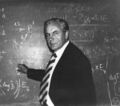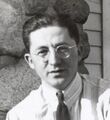Template:Selected anniversaries/June 3: Difference between revisions
No edit summary |
No edit summary |
||
| Line 1: | Line 1: | ||
<gallery> | <gallery> | ||
||1659 | ||1659: David Gregory born ... mathematician and astronomer. | ||
File:Scopoli Giovanni Antonio.jpg|link=Giovanni Antonio Scopoli (nonfiction)|1723: Physician, geologist, and botanist [[Giovanni Antonio Scopoli (nonfiction)|Giovanni Antonio Scopoli]] born. He will be called the "first anational European" and the "Linnaeus of the Austrian Empire". | File:Scopoli Giovanni Antonio.jpg|link=Giovanni Antonio Scopoli (nonfiction)|1723: Physician, geologist, and botanist [[Giovanni Antonio Scopoli (nonfiction)|Giovanni Antonio Scopoli]] born. He will be called the "first anational European" and the "Linnaeus of the Austrian Empire". | ||
||1726 | ||1726: James Hutton born ... geologist and physician. | ||
File:Opium War.jpg|link=|1839: In Humen, China, Lin Tse-hsü destroys 1.2 million kg of opium confiscated from British merchants, preliminary to the [[First Opium War (nonfiction)|First Opium War]]. | File:Opium War.jpg|link=|1839: In Humen, China, Lin Tse-hsü destroys 1.2 million kg of opium confiscated from British merchants, preliminary to the [[First Opium War (nonfiction)|First Opium War]]. | ||
||1853 | ||1853: Flinders Petrie born ... archaeologist and academic. | ||
|| | ||1868: Aristides Agramonte y Simoni born ... pathologist and bacteriologist who was a member of the Reed Yellow Fever Board of the U.S. Army that discovered (1901) the role of the mosquito in the transmission of yellow fever. In May 1898, he was appointed Acting Assistant Surgeon in the U.S. Army. Agramonte had acquired immunity to yellow fever from a mild childhood case in Cuba before emigrating to the U.S., which was an advantage when he was chosen by the Surgeon-General to study the yellow fever outbreak in General Shafter's army in Cuba. There Agramonte performed autopsies in order to determine the causative agent of the disease. After additional work in Cuba, in May 1900, Agramonte was appointmented to Walter Reed's Yellow Fever Commission. Pic. | ||
||1889 | ||1873: Otto Loewi born ... pharmacologist and psychobiologist, Nobel Prize laureate. | ||
||1889: The first long-distance electric power transmission line in the United States is completed, running 14 miles (23 km) between a generator at Willamette Falls and downtown Portland, Oregon. | |||
File:Herman_Hollerith.jpg|link=Herman Hollerith (nonfiction)|1891: Inventor [[Herman Hollerith (nonfiction)|Herman Hollerith]] uses punched card analyzer to anticipate [[crimes against mathematical constants]]. | File:Herman_Hollerith.jpg|link=Herman Hollerith (nonfiction)|1891: Inventor [[Herman Hollerith (nonfiction)|Herman Hollerith]] uses punched card analyzer to anticipate [[crimes against mathematical constants]]. | ||
||1899 | ||1899: Georg von Békésy born ... biophysicist and academic, Nobel Prize laureate. | ||
||1900 | ||1900: Adelaide Ames born ... astronomer and academic. | ||
||1900 | ||1900: Leo Picard born ... geologist and academic. | ||
||1906 | ||1906: R. G. D. Allen born ... economist, mathematician, and statistician. | ||
||Helene (Hel) Braun | ||1914: Helene (Hel) Braun born ... mathematician who specialized in number theory and modular forms; proving the convergence of the Eisenstein series. She also wrote an autobiography, ''The Beginning of A Scientific Career'', describing her experience as a female scientist in the Third Reich. No pic. | ||
||1916 | ||1916: The National Defense Act is signed into law, increasing the size of the United States National Guard by 450,000 men. | ||
File:Igor Shafarevich.jpg|link=Igor Shafarevich (nonfiction)|1923: Mathematician and dissident [[Igor Shafarevich (nonfiction)|Igor Shafarevich]] born. He will make fundamental contributions to algebraic number theory, algebraic geometry, and arithmetic algebraic geometry. | File:Igor Shafarevich.jpg|link=Igor Shafarevich (nonfiction)|1923: Mathematician and dissident [[Igor Shafarevich (nonfiction)|Igor Shafarevich]] born. He will make fundamental contributions to algebraic number theory, algebraic geometry, and arithmetic algebraic geometry. | ||
| Line 32: | Line 34: | ||
File:Karl Menger 1970.jpg|link=Karl Menger (nonfiction)|1927: Mathematician [[Karl Menger (nonfiction)|Karl Menger]] publishes influential paper on applications of [[Game theory (nonfiction)|game theory]] to the detection and prevention of [[crimes against mathematical constants]]. | File:Karl Menger 1970.jpg|link=Karl Menger (nonfiction)|1927: Mathematician [[Karl Menger (nonfiction)|Karl Menger]] publishes influential paper on applications of [[Game theory (nonfiction)|game theory]] to the detection and prevention of [[crimes against mathematical constants]]. | ||
||Arthur Amos Noyes | ||1936: Arthur Amos Noyes dies ... chemist, educator, and inventor. Along with Willis Rodney Whitney, he formulated the Noyes–Whitney equation, which relates the rate of dissolution of solids to the properties of the solid and the dissolution medium. Pic. | ||
||1943 | ||1943: In Los Angeles, California, white U.S. Navy sailors and Marines clash with Latino youths in the Zoot Suit Riots. | ||
File:Melvin Dresher.jpg|link=Melvin Dresher (nonfiction)|1964: Mathematician [[Melvin Dresher (nonfiction)|Melvin Dresher]] (Dreszer) detects and prevents a matrix of [[crimes against mathematical constants]] using the game theoretical model of cooperation and conflict known as the Prisoner's Gnomon dilemma. | File:Melvin Dresher.jpg|link=Melvin Dresher (nonfiction)|1964: Mathematician [[Melvin Dresher (nonfiction)|Melvin Dresher]] (Dreszer) detects and prevents a matrix of [[crimes against mathematical constants]] using the game theoretical model of cooperation and conflict known as the Prisoner's Gnomon dilemma. | ||
||1965 | ||1965: The launch of Gemini 4, the first multi-day space mission by a NASA crew. Ed White, a crew member, performs the first American spacewalk. | ||
||1971 | ||1971: Heinz Hopf, German-Swiss mathematician and academic (b. 1894) worked on the fields of topology and geometry. | ||
||Archibald Vivian Hill | ||1977: Archibald Vivian Hill dies ... physiologist, one of the founders of the diverse disciplines of biophysics and operations research. He shared the 1922 Nobel Prize in Physiology or Medicine for his elucidation of the production of heat and mechanical work in muscles. | ||
||Naum Ilyich Akhiezer | ||1980: Naum Ilyich Akhiezer dies ... mathematician of Jewish origin, known for his works in approximation theory and the theory of differential and integral operators. He is also known as the author of classical books on various subjects in analysis, and for his work on the history of mathematics. | ||
||Robert Norton Noyce | ||1990: Robert Norton Noyce dies ... engineer who co-founded Fairchild Semiconductor in 1957 and Intel Corporation in 1968. He is also credited (along with Jack Kilby) with the realization of the first integrated circuit or microchip that fueled the personal computer revolution and gave Silicon Valley its name. Pic. | ||
||1991 | ||1991: Maurice Krafft dies ... volcanologist and geologist. | ||
||1991 | ||1991: Lê Văn Thiêm dies ... mathematician and academic/ | ||
||Peter John Landin | ||2009: Peter John Landin dies ... computer scientist. He was one of the first to realize that the lambda calculus could be used to model a programming language, an insight that is essential to development of both functional programming and denotational semantics. Pic. | ||
File:Arnold's cat map.png|link=Arnold's cat map (nonfiction)|2009: [[Arnold's cat map (nonfiction)|Arnold's cat map]] is "better than a laser pointer for keeping a cat amused," says [[Vladimir Arnold (nonfiction)|Arnold]]. | File:Arnold's cat map.png|link=Arnold's cat map (nonfiction)|2009: [[Arnold's cat map (nonfiction)|Arnold's cat map]] is "better than a laser pointer for keeping a cat amused," says [[Vladimir Arnold (nonfiction)|Arnold]]. | ||
Revision as of 18:16, 15 August 2018
1723: Physician, geologist, and botanist Giovanni Antonio Scopoli born. He will be called the "first anational European" and the "Linnaeus of the Austrian Empire".

1839: In Humen, China, Lin Tse-hsü destroys 1.2 million kg of opium confiscated from British merchants, preliminary to the First Opium War.
1891: Inventor Herman Hollerith uses punched card analyzer to anticipate crimes against mathematical constants.
1923: Mathematician and dissident Igor Shafarevich born. He will make fundamental contributions to algebraic number theory, algebraic geometry, and arithmetic algebraic geometry.
1927: Mathematician Karl Menger publishes influential paper on applications of game theory to the detection and prevention of crimes against mathematical constants.
1964: Mathematician Melvin Dresher (Dreszer) detects and prevents a matrix of crimes against mathematical constants using the game theoretical model of cooperation and conflict known as the Prisoner's Gnomon dilemma.
2009: Arnold's cat map is "better than a laser pointer for keeping a cat amused," says Arnold.
2010: Mathematician and academic Vladimir Arnold dies. He helped develop the Kolmogorov–Arnold–Moser theorem regarding the stability of integrable systems.






